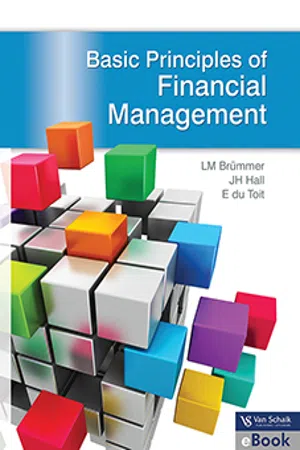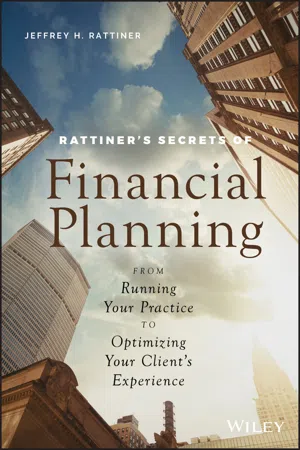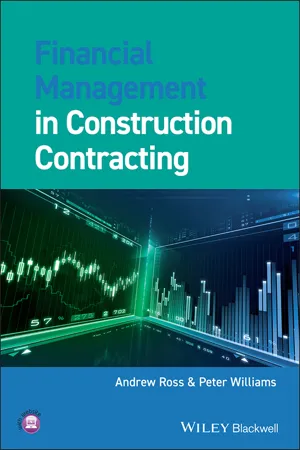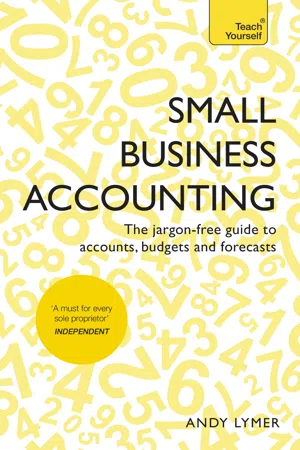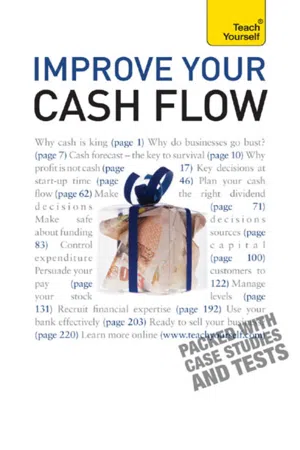Cash Flow Budget
A cash flow budget is a financial tool used to forecast the inflows and outflows of cash within a specific period, typically monthly or annually. It helps businesses plan and manage their cash resources by estimating when money will be received and when it will be spent, providing a clear picture of the company's financial health and liquidity.
8 Key excerpts on "Cash Flow Budget"
- eBook - ePub
Financial Accounting (RLE Accounting)
An Introduction
- John Blake(Author)
- 2013(Publication Date)
- Routledge(Publisher)
...Any knowledgeable lender is likely to insist on production of a cash budget, sometimes called a ‘cash flow forecast’, when considering a loan application. When preparing the cash budget the accountant will need to be aware of the plans for each department of the business, and will compute the amount and timing of the cash flows relating to each transaction. The forecast sales are likely to be of particular significance, since these affect not only the amounts to be raised from debtors but will also be related to production, selling, and distribution costs. Under examination conditions the amount of data relating to forecasts provided will necessarily be restricted. Examination questions on cash budgets are often used by examiners as an opportunity to test the student's grasp of accounting principles, in recognizing the relationship between cash flow and the amounts reported in the accounts. Example 32 offers an illustration of the way in which a question on cash budgets might be presented; the period of two months is shorter than normally required, and has been chosen to simplify the illustration. Figure 70 shows how the cash budget would be presented. A column is shown for each month covered. Forecast inflows are totalled, forecast outflows are totalled, so that the net inflow or outflow can be computed. The cash balance brought forward is then adjusted to reflect the net inflow or outflow, and the new cash balance is carried forward to the following month. Figure 70 The workings prepared in drawing up the cash budget are shown in Figure 71. The steps taken are: 1 The estimate of future sales is the basis of computing the expected cash inflows from debtors; in so far as a proportion of bad debts is expected, it follows that no cash inflow will arise from that part of sales. The workings in Figure 71 show the way in which the cash inflow from debtors for each month would be computed. 2 There are a number of ways in which the cost of sales information can be presented...
- eBook - ePub
- Brümmer LM, Hall JH, Du Toit E(Authors)
- 2017(Publication Date)
- Van Schaik Publishers(Publisher)
...It has been said that cash represents the lifeblood of the organisation. The cash flow forecast, as an integral part of the financial planning process, is an important tool in the hands of the financial manager to forecast and manage the cash flow of an organisation. A thorough understanding and correct application of the cash budget of an organisation is critical for enhancing profitability, managing future cash flow and ensuring the short- and long-term sustainability of the organisation. Conclusion In this chapter we discussed financial planning in terms of budgets, highlighting their conditions and functions. Thereafter the cash budget was introduced and the importance of the lagging effect of cash collections of debtors was illustrated. The role of the proforma Statement of Comprehensive Income and Statement of Financial Position was discussed. Progress reporting and control of budget deviations was deliberated. The chapter concluded by underlining the importance of budgets as a financial management tool. Self-test questions Prepare a cash flow projection for Coldstart (Pty) Ltd for the months December, January and February from the following information, using the format provided. Coldstart (Pty) Ltd had sales of R50 000 in October and R60 000 in November. Expected sales for December, January and February are R70 000, R80 000 and R100 000 respectively. The balance in the bank at the end of November was R5 000. 140 Of the organisation’s sales, 20% are for cash, 60% are collected one month after sales have taken place, and 20% two months after that. The company collects R2 000 every month for a surplus storeroom it sublets. Expected purchases are R50 000, R70 000 and R80 000 for December to February, respectively. This will be paid in cash. Rent for offices is R3 000 per month. Salaries are paid in the form of commission of 10% of sales...
- eBook - ePub
Rattiner's Secrets of Financial Planning
From Running Your Practice to Optimizing Your Client's Experience
- Jeffrey H. Rattiner(Author)
- 2020(Publication Date)
- Wiley(Publisher)
...But before cash flow management can occur, the client needs to set up their system of controls properly. That's where budgeting comes in. Managing Cash Flow Cash Flow Planning Budgeting Change in Cash Flow Alignment Emergency Fund Planning Debt Management Ratios Consumer Debt Housing Costs Total Debt Savings Strategies Debt Management Secured vs. Unsecured Debt Buy vs. Lease/Rent Mortgage Financing Types of Mortgages Home Equity Loan and Line of Credit Refinancing BUDGETING A budget is used to plan and evaluate the income, expenses, and spending patterns of an individual or couple. It should provide a realistic estimate of the individual's income and expenditures, prepared using actual historical information and considering the individual's financial goals and time frame for achieving those goals. It then serves as a control document to compare actual spending to desired spending. There are three stages of the budgeting process: Estimate income (gross or “net” after taxes). Estimate expenditures (both fixed and variable expenses, while also keeping inflation in mind). Budget for savings (should be planned as an integral part of the budget and not just as a “hoped-for” residual amount). The resulting savings at the end of the budget period are sometimes referred to as “discretionary cash flow” since this is the amount that remains for investment after payment of all monthly expenses (including taxes). It's important to reflect taxes into the calculations because our clients will generally not have choices to defer or eliminate. Clients will have to pay for their expenses after taxes are figured into the calculation, from the net amount. Lastly, it is impossible for a client to grow their net worth without having some discretionary cash flow that is available to them for investment purposes. Rattiner's Secrets: When developing a budget, it is important to determine the necessity of certain daily, monthly, or annual expenses...
- eBook - ePub
- Andrew Ross, Peter Williams(Authors)
- 2012(Publication Date)
- Wiley-Blackwell(Publisher)
...This can be defined as an estimate of the timing and amounts of cash inflows and outflows over a specific period (usually one year). A cash flow forecast shows if a firm needs to borrow, how much, when, and how it will repay the loan. It provides vital information on the efficiency of the firm and also allows the firm time to plan if it requires to source finance. Cash inflows are the receipt of cash into a business. They would include payment for work complete, interim payments for continuing work, payment for materials on site and payment from other organisations for services offered. The cash outflows are the transfer of cash from the business to creditor organisations. This would include payment for materials, subcontract payments, staff salaries, repayment of loans as well as purchase of capital equipment. The net monthly cash flow is simply the balance of a month’s total cash inflows in relation to the months total cash outflows. Businesses need to forecast the cash flow on a monthly basis to allow them to predict their finance requirements and to estimate whether they have the capacity to undertake additional work in the future. 11.3.3 Client and contractor A construction project client does not use a cash flow projection in the same way as a contractor, as generally the funding has been secured prior to the project commencing and the client ‘draws down’ from the fund to pay interim valuations. The client therefore only requires an estimate of the monthly amounts that will need to be paid. These amounts will often include costs for site acquisition, planning and design team fees, which will be incurred well before the construction project commences...
- eBook - ePub
Solutions
Business Problem Solving
- Frank Fletcher, Eric Bolland, Eric Bolland(Authors)
- 2016(Publication Date)
- Routledge(Publisher)
...It includes the cost of acquisition of new assets as well as the maintenance and replacement of existing assets. • A special projects budget will forecast costs associated with a particular upcoming company project. These costs may include materials, labor and other expenses. • The Cash Flow Budget estimates the company’s future cash flows over a particular period. The Cash Flow Budget is particularly important to help a company estimate when it may need to use outside financing sources or tap into reserves to cover a cash shortfall in a particular period. We’ll talk about the cash conversion cycle and financing options later in this chapter. In this traditional series of activities, the finance manager generally oversees the process. It might work something like this. At the beginning of the process, senior management meets to develop business targets based on company strategy. The finance manager pulls together historical data for each area and presents each business unit manager with a package. This package may include historical financial data, a budget template, new corporate goals and objectives, and a deadline for when the budget numbers are due back to the finance department. The finance manager will collect the completed budget templates and will combine them into a master budget. This budget is presented to senior management. And that’s where the fun begins. What follows is often an exercise in negotiation as opposed to an exercise in forecasting a realistic budget...
- eBook - ePub
Small Business Accounting
The jargon-free guide to accounts, budgets and forecasts
- Andy Lymer(Author)
- 2015(Publication Date)
- Teach Yourself(Publisher)
...25 Budgeting and cash-flow forecasting In this chapter you will learn: • How to budget for the future • How to plan your expenditure • How to keep your finances in check Thus far the accounting system in this book has been backward-looking, recording how well the business has performed in the past. Good financial control of a business should also be a forward-looking process, planning in advance how much cash or overdraft facility will be needed to cover future business needs. Preparing a budget of future costs and forecasting business cash-flow is a helpful discipline to get into, although many small businesses don’t do it. The method set out here aims to minimize the amount of work involved while still giving you a useful prediction to help you manage the financial aspects of your business. An ideal way to prepare budgets and cash-flow forecasts is to use a computer program known as a spreadsheet. Microsoft Excel™ is one of the market leading programs, but there are many others that are similar in operation (e.g. perhaps try Open Office spreadsheet – it is freely available online). Spreadsheet programs are useful in this whole area because they allow assumptions to be changed easily in order to reveal the effects of the changes on business finances. Chapter 27 outlines computerization issues. Budgeting The budgeting process is an essential part of costing, which is dealt with in the next chapter. A large part of the budgeting process reflects the sorts of calculations that you may be familiar with from your own personal finances, calculating monthly outgoings and anticipating the timing of bills. These same skills apply to budgeting for a business. At the outset, however, an important distinction between what are called ‘fixed’ and ‘variable’ costs must be understood. In the situation of Grace Morris’s shop, some costs are quite fixed in amount, and can be accurately predicted in advance...
- eBook - ePub
- Robert McCallion, Alan Warner(Authors)
- 2010(Publication Date)
- Teach Yourself(Publisher)
...5 Cash flow planning In this chapter: the business plan as starting point the impact of working capital the impact of capital expenditure linking profit and cash plans taxation payments the dividend decision short-term cash planning longer-term cash forecasts The business plan as starting point So far our emphasis has been almost entirely on the cash flow issues that arise when starting a business; now it is time to move on to the cash implications of running the business on an ongoing basis. The principles are in most cases very similar and the drivers of cash flow are the same, but this ongoing context allows us to say much more about the practice of financial planning. There is no magic about financial planning; in its simplest form, it is no more than the production of financial statements in advance. The main difficulties arise, not from any technical or conceptual problems, but because forecasting ahead is a difficult process requiring sound business judgement and an effective crystal ball! But the words of Eleanor Roosevelt should be remembered at all times – ‘it is better to light a candle than to curse the darkness’. The need for planning ahead is more than just a cash flow and financial issue; it requires a business plan which should be a regular feature of any company’s management processes and the foundation of the financial plan. In this chapter we will be assuming that the business and financial plans are produced annually, which ties in with the central reporting framework used by taxation and regulatory bodies in all countries. The period of a year is also the normal planning cycle and seems to work well for most sectors. However, this assumption needs re-assessing in the context of each unique business; for the very fast-moving high-tech company, a year is a long time and the shorter planning cycles of three and six months may be more valid...
- Michael Chibili(Author)
- 2019(Publication Date)
- Routledge(Publisher)
...5 The cash flow statement (also called the statement of cash flow) 5.1 Cash in the business 5.2 Establishing cash flow statements 5.3 A worked example in the establishment of the SCF using the indirect method Companies can only survive if they have enough cash in hand to be able to take care of all their expenses. Cash is considered as the lifeblood of any business. Users of financial statements who assess only the statement of profit and loss to try and determine the financial health of the company might later on realize that their assessment may have been incorrect. Profitable companies have been known to have suddenly failed because they did not adequately manage their cash flows. An understanding of the importance and management of cash is a must if any company’s management would want to avoid sudden liquidity problems. Section 5.1 discusses the place of cash in a business, while at the same time differentiating profits from cash. Section 5.2 provides the rules in the establishment of the cash flow statement, while Section 5.3 is a worked example of the cash flow statement using one of the well established methods. 5.1 Cash in the business Cash is money, in the form of notes and coins, which constitutes payment for goods or services at the time of their purchase or consumption. Cash is not only cash in hand but also deposits and overdrafts which are commonly called cash equivalents. All transactions whether they are settled immediately or settled in the future are ultimately conducted by cash or cash equivalents. Just like all other assets, cash is an asset with the same properties like other assets, and also many more...

